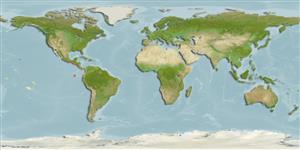>
Anguilliformes (Eels and morays) >
Ophichthidae (Snake eels) > Ophichthinae
Etymology: Quassiremus: Latin, quasso, quassus, = to shake + Lati, remus, -i = oars.
More on authors: Jordan & Bollman.
Environment: milieu / climate zone / depth range / distribution range
Ekologi
marina revassocierade; djupintervall 3 - 30 m (Ref. 5227). Tropical
Eastern Central Pacific: Gulf of California to Costa Rica; reported from the Galapagos Islands (Ref. 5227).
Size / Vikt / Age
Maturity: Lm ? range ? - ? cm
Max length : 71.0 cm TL hane/ej könsbestämd; (Ref. 5227)
Lives in sand flats and rocky areas mixed with boulders, gravel rubble and sand. Can bury and move beneath sand or gravel rubble (Ref. 5227).
Life cycle and mating behavior
Könsmognad | Reproduktion | Lek | Ägg | Fecundity | Larver
Allen, G.R. and D.R. Robertson, 1994. Fishes of the tropical eastern Pacific. University of Hawaii Press, Honolulu. 332 p. (Ref. 11482)
IUCN Red List Status (Ref. 130435: Version 2024-1)
Threat to humans
Harmless
Human uses
Verktyg
Special reports
Download XML
Internet-källor
Estimates based on models
Preferred temperature (Ref.
123201): 22.4 - 29.1, mean 28 °C (based on 114 cells).
Phylogenetic diversity index (Ref.
82804): PD
50 = 0.5625 [Uniqueness, from 0.5 = low to 2.0 = high].
Bayesian length-weight: a=0.00091 (0.00039 - 0.00215), b=2.99 (2.79 - 3.19), in cm total length, based on LWR estimates for this (Sub)family-body shape (Ref.
93245).
Trofisk nivå (Ref.
69278): 3.8 ±0.6 se; based on size and trophs of closest relatives
Resiliens (Ref.
120179): Mellan, lägsta populationsfördubblingstid 1,4-4,4 år (Preliminary K or Fecundity.).
Fishing Vulnerability (Ref.
59153): Moderate to high vulnerability (48 of 100).
